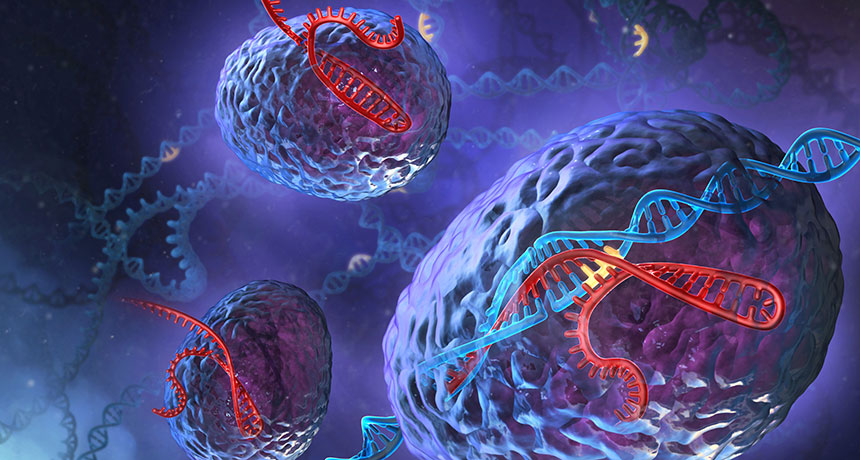Year in review: Breakthrough gene editor sparks ethics debate
Researchers use CRISPR to edit nonviable human embryos

CUT AND PASTE This year, the gene editing system CRISPR has opened the door to new scientific advancements — and ethical concerns.
Illustration created by Stephen Dixon and Feng Zhang
- More than 2 years ago
![]() A revolutionary gene-editing technology made headlines this year as much for the ethical and societal issues it raised as for the scientific accomplishments it enabled.
A revolutionary gene-editing technology made headlines this year as much for the ethical and societal issues it raised as for the scientific accomplishments it enabled.
CRISPR (pronounced crisper) burst on the scientific scene in 2012, when researchers transformed what had originally been identified as a rudimentary immune system in bacteria into one of the most powerful tools in molecular biology. Composed of RNA and an enzyme that slices up invading viruses, CRISPR allows researchers to edit nearly any gene in any organism much more precisely and efficiently than older methods.
Many people hope doctors will soon find a way to use the gene editor to fix mutations that cause genetic diseases, a boon for gene therapy. But that potential also comes with big concerns about the possibility of human germline editing — altering eggs, sperm, embryos or other tissue in such a way that the change could be inherited (SN: 5/30/15, p. 16). Those concerns came to the forefront in April when researchers in China announced that they had attempted to use the system to edit nonviable human embryos (SN Online: 4/23/15). The experiment was partially successful, but the team concluded that there are still hurdles to overcome before CRISPR is safe for clinical use. Publication of the paper horrified many in the field who were already calling for a moratorium on human germline editing. The wider public started thinking again about designer babies and a real-world Gattaca.
In early December, an international summit of experts convened by the U.S. National Academies of Sciences and Medicine, the Chinese Academy of Sciences and the United Kingdom’s Royal Society hashed through scientific, ethical and governance issues associated with human gene editing. “We’re on the verge of a technological breakthrough that could change the future of mankind, and we should not blindly charge ahead,” said U.S. Rep. Bill Foster, a member of the House Committee on Science, Space and Technology.
CRISPR is a major improvement over previous gene-editing systems because it doesn’t require researchers to customize proteins for every DNA cut. Instead, researchers design an RNA that binds to the gene to be edited. The RNA guides an enzyme called Cas9 to the gene, where the enzyme snips the DNA. Depending on the goal, the editing system, officially known as CRISPR/Cas9, can disable or repair a gene or paste a new gene in the specified location. Researchers can create a usable CRISPR system in days, compared with weeks or months for other systems, says Mark Osborn, a molecular geneticist at the University of Minnesota Medical School in Minneapolis.
Story continues after table
Easier editing
Compared with existing gene-editing technology, the CRISPR/Cas9 system is simpler to develop and faster to produce.
| Platform | Year developed | First used in live animals | Time to do an experiment |
|---|---|---|---|
| Zinc finger nucleases | 1996 | 2002 | Months/year |
| TALENs | 2010-2011 | 2011 | Week(s) |
| CRISPR/Cas9 | 2012 | 2012-2013 | Days |
The technology was first described by Jennifer Doudna of the University of California, Berkeley, Emmanuelle Charpentier of the Max Planck Institute for Infection Biology in Berlin and colleagues. But Feng Zhang of the Broad Institute of MIT and Harvard (SN: 10/3/15, p. 20) won the patent rights after submitting evidence that he was the first to devise gene editors based on CRISPR. The researchers’ universities are now embroiled in a lawsuit over who invented the technology first.
Almost immediately after the technology debuted, scientists turned to CRISPR to genetically engineer organisms in the lab, including rhesus macaques, mice, zebrafish, fruit flies, yeast and some plants. In October, researchers reported setting a record for the most genes edited at once (SN: 11/14/15, p. 6). That record — 62 genes — removed viruses embedded in pig DNA to make pig organs safer for human transplants. Chinese researchers announced the same month that they had successfully edited dogs with CRISPR, producing a female beagle with a mutation that resulted in more muscular thighs than her unedited littermates (SN: 11/28/15, p. 16).
CRISPR has also been on the lips of scientists, environmentalists and regulators because of an application of the technology called gene drives — engineered genes designed to break typical inheritance rules and get passed to nearly all of a carrier’s offspring (SN: 12/12/15, p. 16). For more than a decade, scientists have been attempting to construct effective gene drives with the hopes of eradicating mosquito-borne diseases such as malaria and eliminating populations of invasive species. That process becomes much easier with the development of CRISPR.
In March, researchers reported creating a CRISPR gene drive in fruit flies, and in late November and early December, two teams reported the creation of gene drives that could help eradicate malaria. One of the gene drives essentially turns mosquitoes into vaccine distributors for each other; the second sterilizes female mosquitoes (SN Online: 12/7/15). Great promise comes with these developments, but there are also fears that gene drive–altered organisms could escape the lab and infect wild animals or could run amok in other ways. The debates aren’t anywhere near settled. They have barely begun.






